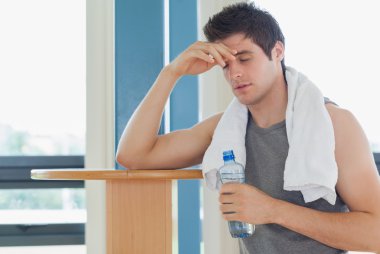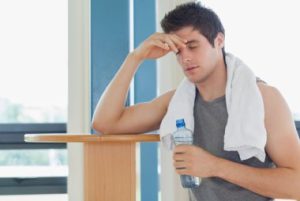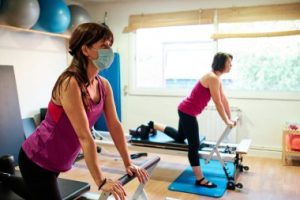
Can You Exercise With Strep Throat (7 Helpful Guidelines)
Can you exercise with strep throat? Pushing through the pain might seem admirable, but exercising with this contagious illness can be more harmful than helpful. Before you lace up your sneakers, consider the risks to your health and the well-being of those around you. Imagine gearing up for your morning jog, only to wake up with a scratchy throat and a feverish haze.
Strep throat, a common yet stubborn bacterial infection, leaves many fitness enthusiasts grappling with the dilemma: can you safely exercise with strep throat? The question isn’t just about endurance or willpower but balancing health, recovery, and the commitment to your fitness goals. Understanding when to push through and when to rest is crucial for anyone facing this unwelcome disruption. Let’s delve into the complexities of exercising with strep throat, weighing the risks and benefits to help you make the best choice for your body and well-being.

Can You Exercise With Strep Throat
Exercising with strep throat is generally not recommended. Strep throat, caused by a bacterial infection, can significantly weaken the body. Engaging in physical activity can exacerbate symptoms and delay recovery. Resting and following prescribed treatments are crucial for a swift recovery. Consult a healthcare provider for personalized advice.
Understanding Strep Throat and Its Impact on the Body
Strep throat is a common bacterial infection caused by Streptococcus pyogenes. Symptoms often include severe sore throat, fever, swollen lymph nodes, and difficulty swallowing. The body requires significant energy to combat this infection, which can lead to fatigue and overall weakness. When contemplating exercise with strep throat, it’s crucial to recognize how this illness strains the immune system. High-intensity workouts can increase this strain, potentially leading to complications such as worsening of symptoms or prolonging the illness. Thus, prioritizing rest is vital for effective recovery.
The Risks of Exercising with Strep Throat
Exercising while suffering from strep throat can pose several risks. The body’s immune system is already working hard to fight the infection, and additional physical stress can hinder this process. Engaging in strenuous activities can lead to dehydration, exacerbating the symptoms of strep throat. Additionally, exercising with a fever, which often accompanies strep throat, can increase the risk of dehydration and heat-related illnesses. Therefore, it’s essential to allow the body ample time to heal.
When Can You Resume Exercise?
Returning to exercise after strep throat should be done cautiously. The general recommendation is to wait until you are fully recovered, with no symptoms of fever, sore throat, or fatigue. Gradually easing back into exercise is advised, starting with low-intensity activities such as walking or gentle stretching. Monitoring your body’s response is crucial; any signs of lingering fatigue or recurring symptoms should be a signal to rest further. Consulting with a healthcare professional can provide personalized guidance on when it is safe to resume your regular exercise routine.
Overview of Strep Throat
Causes and Transmission
Strep throat is a common bacterial infection caused by the Group A Streptococcus bacteria, specifically Streptococcus pyogenes. This infection primarily affects the throat and tonsils, leading to symptoms such as a sore throat, difficulty swallowing, fever, and swollen lymph nodes.
Strep throat is highly contagious and spreads through respiratory droplets, which are expelled when an infected person coughs, sneezes, or talks. These droplets can be inhaled by nearby individuals or land on surfaces, where the bacteria can survive for a limited time, potentially leading to indirect transmission through touch. Close contact in places such as schools, workplaces, and households increases the risk of spreading the infection.
Symptoms and Diagnosis
Strep throat, a bacterial infection caused by Group A Streptococcus, primarily affects the throat and tonsils, leading to a range of symptoms. Patients commonly experience a sore throat and difficulty swallowing, which are hallmark signs of the infection. Accompanying these symptoms are fever, headache, and generalized body aches, which can make the patient feel significantly unwell.
Diagnosis of strep throat involves a combination of clinical evaluation and laboratory tests. The rapid strep test, a quick and convenient diagnostic tool, can detect the presence of streptococcal bacteria within minutes. If the rapid test results are negative but strep throat is still suspected based on clinical symptoms, a throat culture may be performed. This involves swabbing the throat and allowing any bacteria present to grow in a lab setting, providing a more definitive diagnosis, although results take longer to obtain. Prompt diagnosis and treatment are crucial to prevent complications and to ensure a swift recovery.
Treatment
Strep throat is typically treated with antibiotics to eradicate the bacteria, alleviate symptoms, and prevent complications such as rheumatic fever. The first-line antibiotics for treating strep throat are penicillin and amoxicillin due to their effectiveness and low incidence of side effects. These antibiotics not only reduce the duration of symptoms but also decrease the contagious period.
In addition to antibiotics, symptomatic relief is crucial for patient comfort. Over-the-counter pain relievers such as ibuprofen or acetaminophen help reduce fever and alleviate throat pain. Throat lozenges and gargling with warm salt water can also soothe the sore throat. Adequate rest and hydration are essential supportive measures to help the body recover. Together, these treatments ensure a comprehensive approach to managing strep throat, addressing both the underlying infection and its discomforting symptoms.
Exercise and the Immune System
General Impact of Exercise on Immunity
Exercise has a complex relationship with the immune system, with its effects varying significantly depending on the intensity and duration of physical activity. Moderate exercise, such as regular brisk walking, cycling, or light jogging, has been shown to boost immune function. This type of exercise enhances the circulation of immune cells, improves their ability to detect and fight off pathogens, and reduces inflammation, thereby lowering the risk of chronic diseases.
Conversely, intense exercise, particularly when performed without adequate rest and recovery, can suppress the immune response. Prolonged, high-intensity workouts, like marathon running or heavy weightlifting sessions, can lead to a temporary decrease in immune function, increasing susceptibility to infections. This immunosuppressive effect is attributed to the stress and inflammation caused by intense physical exertion, which can temporarily impair the body’s ability to fend off pathogens. Therefore, while regular moderate exercise is beneficial for maintaining a robust immune system, it is crucial to balance intense physical activity with sufficient rest to avoid potential negative impacts on immunity.
Exercise During Illness
Exercising while sick can pose several risks and impact the body’s recovery process. When the body is battling an illness, its immune system is already working hard to combat the infection, requiring substantial energy and resources. Engaging in physical activity during this time can divert energy away from the immune response, potentially prolonging the illness or worsening symptoms.
Additionally, exercising with certain illnesses, such as the flu or a fever, can strain the cardiovascular system and lead to complications such as dehydration, dizziness, and even more severe outcomes like myocarditis, an inflammation of the heart muscle. It’s crucial to listen to one’s body and prioritize rest and recovery, as the energy normally allocated for exercise is better used for fighting off the illness. Rest allows the immune system to function optimally, reducing the duration and severity of the sickness, and ensuring a quicker and more complete recovery.

Specific Considerations for Exercising with Strep Throat
Severity of Symptoms
When dealing with strep throat, it’s crucial to consider the severity of symptoms before deciding to exercise. For those experiencing mild symptoms, such as a sore throat without significant pain or systemic involvement, light exercise like walking or gentle stretching may be permissible, provided it doesn’t exacerbate the condition.
However, severe symptoms, including intense throat pain, difficulty swallowing, or systemic involvement such as fever, body aches, and fatigue, necessitate refraining from physical activity. Exercising with a fever can be particularly risky as it indicates that the body is fighting a more serious infection, and engaging in strenuous activity can further stress the immune system, potentially prolonging recovery and increasing the risk of complications.
Therefore, it is recommended to rest and allow the body to heal, resuming exercise only after symptoms have significantly improved and fever has subsided. Consulting a healthcare professional for personalized advice is always advisable when symptoms are severe.
Risks and Potential Complications
Exercising with strep throat presents several significant risks and potential complications that should not be overlooked. Firstly, engaging in physical activity can prolong the illness by straining the body, which is already weakened and fighting off the infection. This can lead to a delayed recovery and exacerbation of symptoms, leaving individuals feeling unwell for a longer period.
Secondly, the risk of spreading the infection is heightened, especially in communal settings like gyms or sports teams, where close contact and shared equipment can facilitate the transmission of the Streptococcus bacteria to others. This not only puts others at risk but can also contribute to larger outbreaks.
Lastly, strep throat, if not properly treated or if aggravated by intense physical exertion, can lead to severe complications such as rheumatic fever or glomerulonephritis. Rheumatic fever can cause lasting damage to the heart valves, while glomerulonephritis can result in kidney damage, both of which are serious health issues requiring extensive medical intervention. Therefore, it is crucial to prioritize rest and complete the full course of prescribed antibiotics before resuming any physical activities to avoid these potential complications.
Impact on Performance and Recovery
Exercising with strep throat poses significant challenges and risks, particularly impacting physical performance and recovery. The infection typically causes symptoms such as fever, sore throat, and fatigue, which substantially decrease one’s physical capabilities. Engaging in physical activities during this time can exacerbate these symptoms, leading to decreased stamina, strength, and overall performance.
Additionally, the body’s immune system is already working hard to fight off the bacterial infection, and the added stress of exercise can hinder this process, delaying recovery time. Pushing through strenuous activities might also increase the risk of complications, such as the spread of infection or the development of more severe illnesses. Therefore, it’s crucial to prioritize rest and allow the body to heal fully before resuming any intensive exercise regimen. This approach not only ensures a more efficient recovery but also helps prevent the potential long-term impacts on health and fitness.

Medical Advice and Guidelines
Medical Recommendations
When contending with strep throat, prioritizing rest and hydration is paramount to facilitate recovery. Engaging in vigorous exercise while battling this bacterial infection can exacerbate symptoms and prolong healing. It’s crucial to heed the body’s signals and refrain from physical exertion until symptoms subside and post-antibiotic treatment.
While exercise is typically beneficial for overall health, pushing through illness can compromise the immune system and impede recovery. Once symptoms have abated and a course of antibiotics has been completed, gradually reintroducing exercise is advisable, beginning with low-intensity activities like walking or gentle stretching. Prioritizing rest, proper nutrition, and hydration remain essential components of the recovery process, ensuring a swift return to optimal health and fitness. Always consult a healthcare provider for personalized medical advice tailored to individual circumstances.
Guidelines from Health Organizations
When dealing with strep throat, it’s crucial to prioritize rest and recovery, especially during the acute phase of the illness. While exercise is generally beneficial for overall health, engaging in strenuous physical activity when battling strep throat can exacerbate symptoms and prolong the recovery process. Health organizations like the CDC and Mayo Clinic typically advise individuals to refrain from exercising while they are ill, including when they have strep throat.
It’s essential to listen to your body and prioritize restorative measures such as staying hydrated, getting plenty of sleep, and taking prescribed medications to alleviate symptoms. Additionally, seeking medical advice from healthcare providers is paramount. They can provide personalized recommendations based on the severity of your symptoms and overall health status. In some cases, mild physical activity like gentle stretching or short walks may be tolerated, but it’s crucial to consult with a healthcare professional before engaging in any exercise regimen while recovering from strep throat.
Safe Practices for Exercising Post-Illness
Gradual Return to Exercise
After recovering from strep throat, it’s crucial to ease back into your exercise routine gradually to ensure a safe and effective recovery. Begin with light activities such as walking or gentle stretching to reintroduce movement to your body without overexerting yourself. It’s important to monitor your symptoms and energy levels closely during this time.
Listen to your body and avoid pushing yourself too hard, as this can potentially prolong your recovery or lead to setbacks. By gradually reintroducing exercise and paying attention to how your body responds, you can safely regain your strength and fitness levels post-illness. Remember, patience and self-care are key components of a successful recovery journey.
Adjusting Workout Intensity and Duration
Adjusting workout intensity and duration is paramount in ensuring a safe return to physical activity. Start by gradually increasing the intensity of your workouts over time. This progressive approach allows your body to readjust and rebuild its strength without risking overexertion or setbacks.
Additionally, listen attentively to your body’s signals during exercise. Pay close attention to any signs of fatigue, discomfort, or weakness, and be prepared to scale back or modify your workout accordingly. By respecting your body’s limits and gradually building back your stamina, you can effectively resume exercising post-illness while minimizing the risk of reinjury or relapse.
Importance of Hydration and Nutrition
After recovering from strep throat, adopting safe exercise practices is crucial for a smooth transition back to physical activity. Hydration plays a pivotal role, especially post-illness, aiding in the flushing out of toxins and supporting overall bodily functions. Ensuring adequate fluid intake helps replenish lost fluids and maintains electrolyte balance, essential for optimal performance.
Moreover, proper nutrition is paramount. A balanced diet rich in protein, vitamins, and minerals is imperative for rebuilding weakened muscles and bolstering immune function post-illness. Protein aids in tissue repair and muscle recovery, while vitamins and minerals support immune function, helping the body fend off potential relapses. Therefore, prioritizing hydration and nutrition post-strep throat not only promotes a faster recovery but also reduces the risk of recurring illness, allowing for a safer and more effective return to exercise.
Psychological Aspects
Impact of Illness on Mental Health
The psychological impact of strep throat extends beyond the physical discomfort, affecting various facets of mental health. Individuals grappling with this illness often experience frustration and anxiety, particularly concerning missed workouts or disruptions in their regular routines. For those accustomed to staying active, the forced hiatus due to illness can induce feelings of restlessness and concern about setbacks in their fitness goals.
Moreover, the persistent discomfort and fatigue associated with strep throat can exacerbate existing stress levels, amplifying feelings of irritability and mood swings. In such times, it becomes crucial to prioritize mental rest and relaxation alongside physical recovery. Embracing moments of stillness and allowing oneself to recuperate mentally can aid in managing the psychological toll of the illness, fostering a sense of calm amidst the storm of symptoms. Thus, recognizing the interconnectedness of physical and mental well-being is essential in navigating the challenges posed by strep throat and promoting holistic healing.
Strategies for Coping
Strep throat, beyond its physical symptoms, can evoke various psychological aspects. The discomfort and pain associated with the illness can lead to feelings of frustration, irritability, and even anxiety or depression in some cases. Additionally, the temporary disruption of daily routines due to illness can cause stress and a sense of loss of control. Coping strategies play a crucial role in managing these psychological aspects.
Mindfulness and stress reduction techniques, such as deep breathing exercises, meditation, or progressive muscle relaxation, can help individuals alleviate stress and promote a sense of calm amidst the discomfort. Setting realistic goals and expectations is also essential; acknowledging the limitations imposed by the illness and allowing oneself the necessary time to rest and recover can prevent feelings of inadequacy or disappointment. By incorporating these coping strategies into their daily routine, individuals with strep throat can better manage the psychological challenges associated with the illness and promote their overall well-being.
FAQs: Can You Exercise With Strep Throat
Q1. Can I exercise if I have strep throat?
A. It’s generally not recommended to exercise when you have strep throat. Strep throat is a bacterial infection that requires rest and proper medical treatment to recover fully. Exercising can strain your body further and potentially prolong your illness.
Q2. Why should I avoid exercising with strep throat?
A. Exercising while having strep throat can exacerbate symptoms, increase the risk of complications, and prolong recovery. Your body needs energy to fight the infection, and physical exertion can divert that energy away from your immune response.
Q3. What are the risks of exercising with strep throat?
A. The risks include worsening your symptoms, such as increased fever, fatigue, and sore throat. Additionally, pushing yourself too hard can lead to more serious complications like rheumatic fever or kidney inflammation.
Q4. How long should I wait to exercise after having strep throat?
A. You should wait until you have completed your course of antibiotics and are free of symptoms. Typically, this means waiting at least 24-48 hours after finishing antibiotics and ensuring you feel completely well before resuming exercise.
Q5. Are there any safe ways to stay active with strep throat?
A. Gentle activities like stretching or light yoga may be acceptable if you feel up to it, but it’s crucial to listen to your body. Avoid any activity that raises your heart rate significantly or makes you feel worse.
Q6. What should I do instead of exercising while recovering from strep throat?
A. Focus on rest, hydration, and taking your prescribed antibiotics. Rest allows your body to heal and fight off the infection more effectively. Light activities like reading, watching TV, or doing puzzles can help pass the time without taxing your body.
Q7. Can I exercise if I only have mild symptoms of strep throat?
A. Even with mild symptoms, it’s best to avoid strenuous exercise. Mild symptoms can quickly worsen with physical exertion. Rest is the safest approach until you’re fully recovered.
Q8. What are signs that I should stop exercising and rest?
A. If you experience increased fever, severe sore throat, difficulty swallowing, or extreme fatigue, you should stop exercising immediately and rest. These are signs that your body needs more energy to fight the infection.
Q9. How can I tell when I’m ready to start exercising again after strep throat?
A. You’re ready to start exercising again when you have completed your antibiotics, are free of symptoms for at least 24-48 hours, and feel fully recovered. Start with light exercise and gradually increase intensity as your body allows.
Q10. What should I tell my doctor about my exercise routine if I have strep throat?
A. Inform your doctor about your regular exercise routine and ask for specific recommendations based on your condition. Your doctor can provide personalized advice on when and how to safely resume physical activities.
Conclusion
Exercising with strep throat is generally not advisable due to the potential risks and complications associated with the infection. Strep throat, caused by the Streptococcus bacteria, often leads to symptoms such as fever, sore throat, and fatigue, which can be exacerbated by physical exertion. Engaging in exercise while ill can weaken the immune system, prolong recovery time, and increase the risk of spreading the infection to others.
It is crucial to prioritize rest and follow medical advice, including taking prescribed antibiotics and maintaining proper hydration. Once symptoms have fully subsided and a healthcare provider has given the all-clear, gradually resuming exercise is typically safe. In summary, while exercise is beneficial for overall health, it is essential to allow the body adequate time to recover from strep throat to ensure a complete and swift recovery.